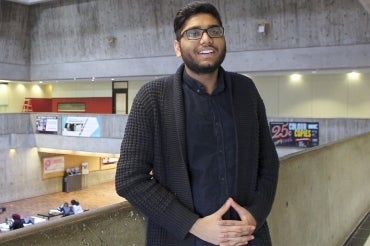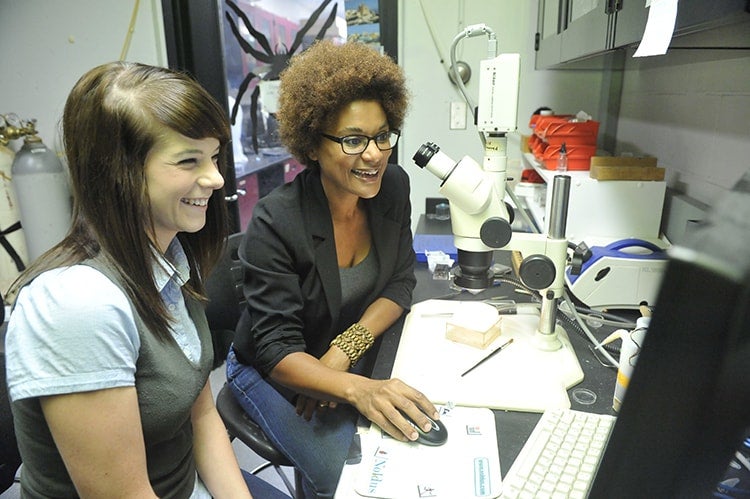U of T Scarborough lab brings in high school students for research opportunities

Published: March 2, 2017
In 2014, Rishawn Dhir’s high school co-op program placed him in the lab of Professor Maydianne Andrade at U of T Scarborough. Little did the eleventh grader know the impact it would have on his academic future.
“The co-op program changed my opinion of university,” says Dhir, who is now a fourth-year neuroscience and health studies student at U of T Scarborough.
“It made me realize that within a lab there are many opportunities, not only for research but to work with other people, to take leadership opportunities and to develop as an individual.”
Since 2012, the high school co-op program has been part of the Andrade Lab, renowned for its primary subjects – black widow spiders. The lab, led by Andrade, a biology professor, explores the mating habits of cannibalistic spiders.

Professor Maydianne Andrade (right) with a student in her lab (photo by Ken Jones)
While U of T Scarborough has a robust set of co-op programs for undergraduate students, the Andrade Lab is one of the few to adapt the plan for Grade 11 and 12 high school students.
“Incorporating high school students is a great way to increase pipelines into the university,” says Andrade. “People in local schools should be aware of what we’re doing here. Co-op high school students are looking for a meaningful experience and to be honest – we need help,” she says.
Today, Dhir leads a team that provides mentorship and discussion between undergraduates and their former high schools. He attributes much of his passion for the program to his experience as a high school student in the lab.
Some of that experience is grunt work – high school students like undergraduates clean spider compartments and help with the practical running of the lab.
After being prepared for working with black widows, students like Danilo Piljevic, an eleventh grader, then get to help with feedings.
“As a Grade 11 student who’s going to apply to university next year, it’s great to have this array of options of people I can talk to, see what it’s like, and see what programs are good for me and which aren’t,” says Piljevic, who attends A.Y. Jackson Secondary School in Scarborough.
Piljevic adds that for three to four hours a week he gets to see if this is something he could imagine himself doing for the rest of his life.
Andrade appreciates the doors the program opens for students.
“We’re connecting with students who are perhaps uncertain about going to university or want to feel their way into whether they want to do biology or something different,” says Andrade.
The structure of the lab allows high schoolers new to the program a chance to work with more senior students, and more motivated senior students area allowed to manage lab assistants or do independent research.
Dhir become a leader in the lab and says it helped build his confidence. After the program, he volunteered during the summer and became a lab assistant.
“I felt confident enough from my experiences to get involved through numerous councils in first year and then creating my own in second year,” says Dhir.
“There are many opportunities for you here as long as you’re confident, push yourself and go out there and look,” he says. “You’ll find them if you try,” says Haneen Altahir, a third-year biochemistry and environmental science student, who also went through the high school co-op program.
Like Dhir, networking with fellow lab personnel and being on campus influenced her university decision.
“After coming to U of T Scarborough every day for co-op, I could imagine being a student here,” she says. “It’s such a community school, and I really wanted to be a part of that.”



